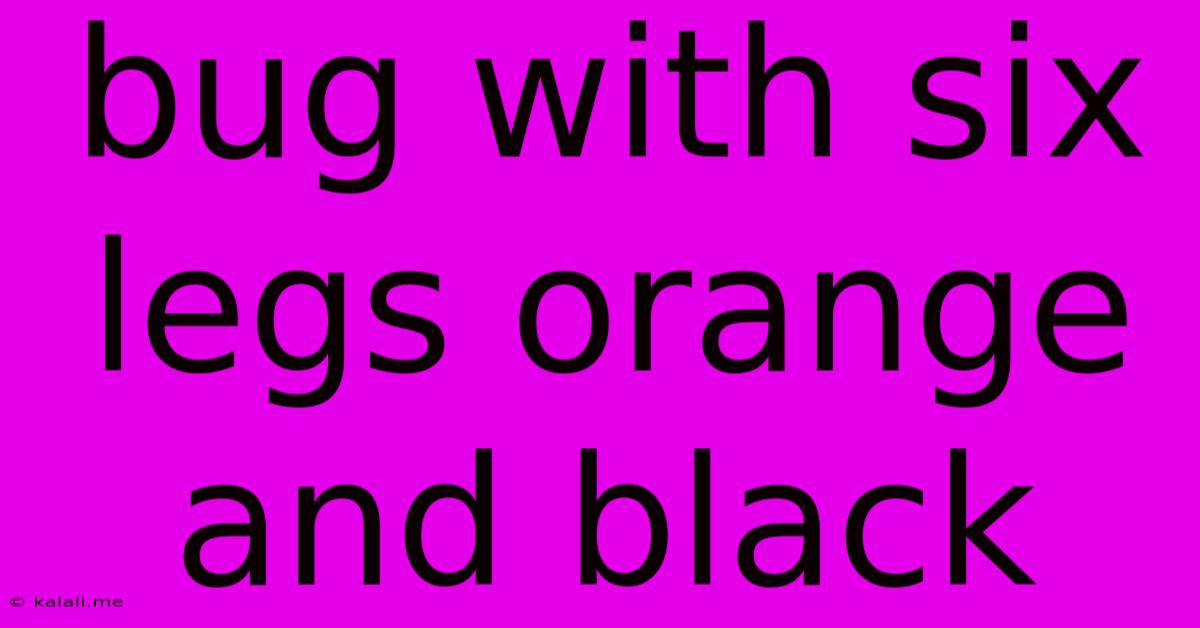Bug With Six Legs Orange And Black
Kalali
May 25, 2025 · 3 min read

Table of Contents
Identifying the Six-Legged Orange and Black Bug: A Comprehensive Guide
Have you spotted a small, six-legged creature with striking orange and black markings? Pinpointing the exact species can be tricky, as many insects share this vibrant color combination. This guide will help you narrow down the possibilities and understand what you might have encountered. Knowing the specific insect is crucial, especially if it's in your home or garden, as it can help determine if it's harmful or beneficial.
Common Insects with Orange and Black Stripes or Spots
Several insect families boast species with orange and black coloration. The most common culprits include:
-
Ladybugs (Coccinellidae): While the classic ladybug is red with black spots, many variations exist, including those with orange or yellow bodies and black markings. These are generally beneficial insects, preying on aphids and other garden pests. Their size, typically less than 1/2 inch, and rounded, dome-shaped bodies are key identifiers.
-
Assassin Bugs (Reduviidae): Some assassin bugs display orange and black patterns. These are predatory insects, feeding on other insects. They can be beneficial in controlling pest populations but caution is advised, as some species possess a painful bite. Their elongated bodies and piercing mouthparts are distinguishing features.
-
Leaf-footed Bugs (Coreidae): Certain leaf-footed bugs show orange and black coloration. These are plant-feeding insects, and while generally not harmful to humans, they can cause damage to plants. Their flattened bodies and leaf-like expansions on their hind legs are unique characteristics.
-
Milkweed Bugs (Oncopeltus fasciatus): These insects, particularly common on milkweed plants, have a distinctive orange and black striped pattern. While they feed on milkweed seeds, they generally don't cause significant harm. Their relatively large size and the bright, contrasting stripes are helpful for identification.
-
Harlequin Bugs (Murgantia histrionica): These shield-shaped insects display bright orange and black markings and are serious plant pests, commonly affecting cruciferous crops like cabbage and broccoli. Their distinctive shield shape is a key identifier.
Refining Your Search: Consider These Factors
To narrow down your insect identification, consider these factors:
-
Size: Measure the insect if possible. This helps significantly in narrowing down the possibilities.
-
Shape: Is the body round, elongated, or shield-shaped? This is a crucial visual characteristic.
-
Location: Where did you see the insect? Was it on a plant, in your home, or outdoors? Habitat provides valuable clues.
-
Behavior: Was the insect crawling, flying, or feeding? Observing its behavior can be informative.
-
Detailed markings: Are the orange and black markings stripes, spots, or a more complex pattern? Take note of the specific arrangement.
Using Online Resources for Identification
Numerous online resources can aid in identifying insects. Websites and apps dedicated to insect identification often feature detailed images and descriptions, allowing you to compare your sighting with known species. Using multiple resources can increase the accuracy of your identification.
When to Seek Professional Help
If you are unable to identify the insect and are concerned about its potential harm to humans, pets, or plants, it's best to seek help from a local entomologist or pest control professional. They possess the expertise to accurately identify the insect and recommend appropriate action.
By carefully observing the insect's physical characteristics, behavior, and location, and utilizing available resources, you can increase your chances of successfully identifying that intriguing orange and black, six-legged creature. Remember, accurate identification is crucial for understanding its role in the ecosystem and any potential impact it might have.
Latest Posts
Latest Posts
-
How To Clean Out Shower Drain
May 25, 2025
-
Does The Pope Shit In The Woods
May 25, 2025
-
Tiling A Niche In A Shower
May 25, 2025
-
How To Remove Dog Urine Smell From Carpet
May 25, 2025
-
How Often Should You Replace Your Brakes
May 25, 2025
Related Post
Thank you for visiting our website which covers about Bug With Six Legs Orange And Black . We hope the information provided has been useful to you. Feel free to contact us if you have any questions or need further assistance. See you next time and don't miss to bookmark.